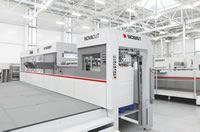He adds that high growth rates for digital label printing are anticipated during the next decade. Despite this, however, many label printers have not yet decided to move to digital. Their main concerns, it seems, are associated with slow printing speeds, the inability to print some spot colours, inadequate workflow solutions and a lack of true inline finishing and embellishment capabilities.
However, thanks to collaboration with Heidelberg and its partner for inkjet technology, Fujifilm, these problems are resolved with the Gallus DCS 340.
Firstly, the print head design enables several heads to be joined together for a greater print width, without visible transitions, and a native resolution of 1 200dpi delivers print quality that Gallus claims is unmatched in UV inkjet printing today. This technology – combined with the speed of flexographic printing and the efficiency of digital printing – is the basis of the Gallus DCS 340.
Another feature is the high register accuracy.
Process flexibility at a whole new level
Digital technology simplifies the handling of variable data and versioning and supports the cost-effective production of short runs. This gives label printers the flexibility expected by their customers.
By combining the strengths of digital printing with optimised finishing, the Gallus DCS 340 gives users the chance to varnish, embellish and further process labels inline – from the roll to the finished die-cut label in a single production operation.
At the same time, a user-friendly interface ensures printers get from the speed, quality and consistency they need. The Heidelberg Prinect Digital Front End is used to automate the prepress workflow and ensure data is prepared efficiently, complete with comprehensive colour management.
Printers also benefit from functions such as spot colour matching, the PDF Toolbox and Prepress Manager for even greater efficiency.
Gallus best seller with a direct matrix stripper
Also new from Gallus is the best-selling ECS 340 press with enhanced productivity and a new high-performance matrix stripper that can execute complex die-cutting contours even at high production speeds.
The innovative functionality of the high-performance matrix stripper represents a masterpiece of mechatronics by Gallus development engineers.
Direct matrix-stripping offers a number of advantages over standard matrix strippers. Using a path roller to guide and support the matrix over a short distance results in far fewer matrix tears, delivering greater process reliability, but complex die-cutting formes – with recessed edges, for example – can remain problematic. The new high-performance matrix stripper was developed by Gallus specifically for matrix removal with highly complex die lines at maximum speeds, giving stable matrix removal at all times.
A benchmark for professional label printing
Visitors to the Gallus Innovation Days also received an insight into ongoing development work. The ‘Looking over the developers’ shoulders’ part of the programme provided a one-off opportunity to get an idea of what the new Gallus RCS 430 – a fresh benchmark in narrow-web label printing – is going to be like.
For the first time since its launch, the Gallus RCS is being completely revamped. It’s being equipped with a state-of-the-art control platform to be ready for future market requirements and technology advances.
This control platform is already in use in the Gallus ECS 340 and Gallus EM S, and promises printers potential synergies by providing a standardised technology platform for a range of machines. Reduced complexity is a further advantage. Having a common control platform simplifies the training of press operators and means staff can easily be assigned to different machines as they’re already familiar with the user interface.










